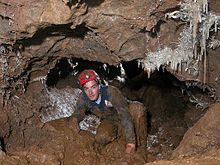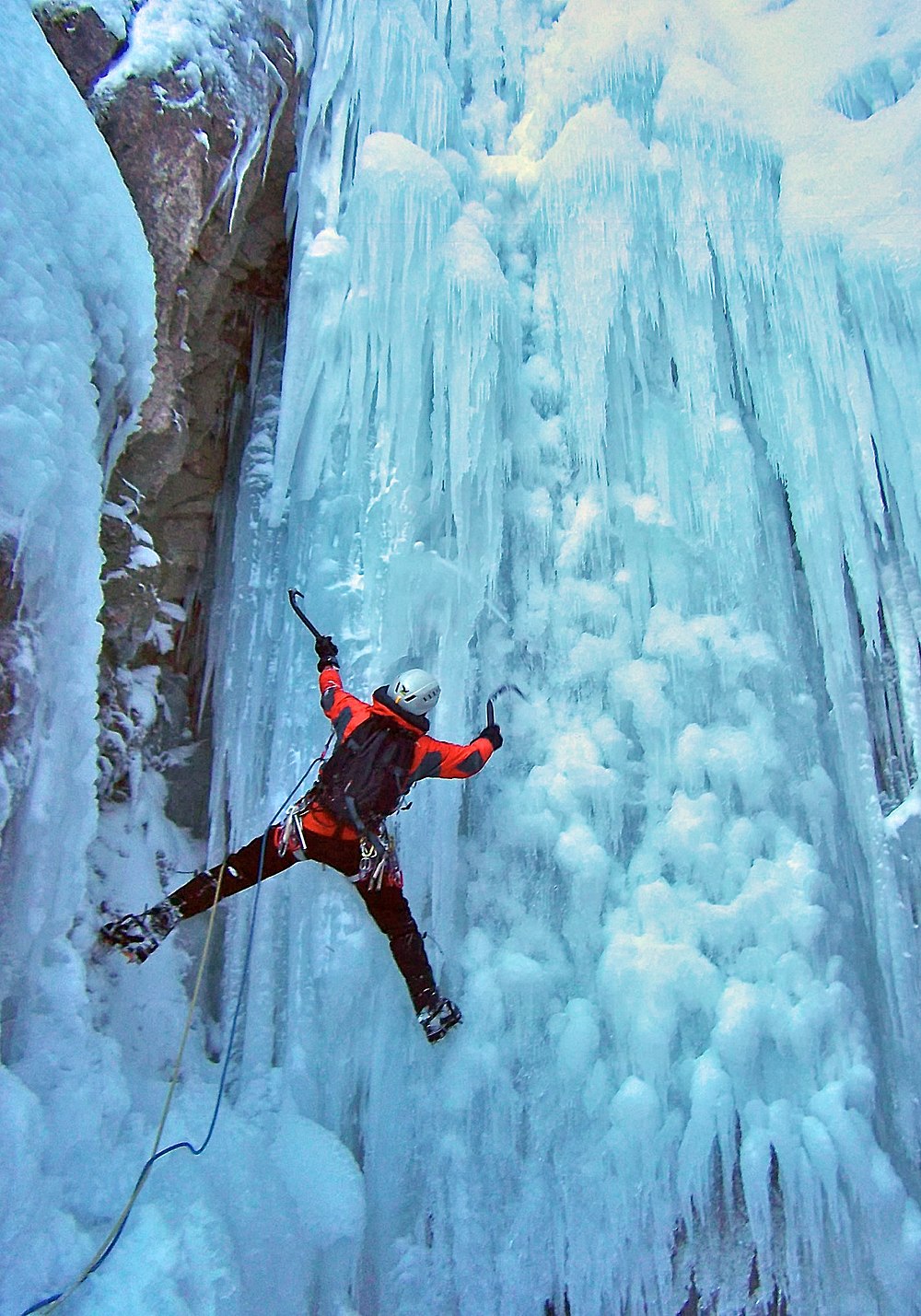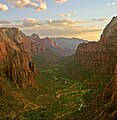The Climbing Portal
Climbing is the activity of using one's hands, feet, or other parts of the body to ascend a steep topographical object that can range from the world's tallest mountains (e.g. the eight thousanders) to small boulders. Climbing is done for locomotion, sporting recreation, for competition, and is also done in trades that rely on ascension, such as construction and military operations. Climbing is done indoors and outdoors, on natural surfaces (e.g. rock climbing and ice climbing), and on artificial surfaces (e.g. climbing walls and climbing gyms) (Full article...)
Random climbing article

A bosun's chair (or boatswain's chair) is a device used to suspend a person from a rope to perform work aloft. Originally just a short plank or swath of heavy canvas, many modern bosun's chairs incorporate safety devices similar to those found in rock climbing harnesses such as safety clips and additional lines.
In addition to the maritime applications they were developed for, bosun's chairs are also used for working at height in various maintenance industries. In commercial window cleaning, the term bosun's chair describes devices suspended from rope and equipped with seatboards, such as descent-only controlled descent apparatuses (CDAs). (Full article...)

Rock climbing is a climbing sports discipline that involves ascending routes consisting of natural rock in an outdoor environment, or on artificial resin climbing walls in a mostly indoor environment. Routes are chronicled in guidebooks, and on online databases, with the details of how to climb the route (called the beta), and who made the first ascent (or FA) and the coveted first free ascent (or FFA). Climbers will try to ascend a route onsight, however, a climber can spend years projecting a route before they make a redpoint ascent.
Routes range from a few metres to over a 1,000 metres (3,300 ft) in height, and traverses can reach 4,500 metres (14,800 ft) in length. They include slabs, faces, cracks and overhangs/roofs. Popular rock types are granite (e.g. El Capitan), limestone (e.g. Verdon Gorge), and sandstone (e.g. Saxon Switzerland) but 43 types of climbable rock types have been identified. Artificial indoor climbing walls are popular and competition climbing — which takes place on artificial walls — became an Olympic sport in 2020.
Contemporary rock climbing is focused on free climbing where — unlike with aid climbing — no mechanical aids can be used to assist with upward momentum. Free-climbing includes the discipline of bouldering on short 5-metre (16 ft) routes, of single-pitch climbing on up to 60–70-metre (200–230 ft) routes, and of multi-pitch climbing — and big wall climbing — on routes of up to 1,000 metres (3,300 ft). Free-climbing can be done as free solo climbing with no climbing protection whatsoever, or as lead climbing that uses either removable temporary protection (called traditional climbing), or permanently fixed bolted protection (called sport climbing).
The evolution in technical milestones in rock climbing is tied to the development in rock-climbing equipment (e.g. rubber shoes, spring-loaded camming devices, and campus boards) and of rock-climbing technique (e.g. jamming, crimping, and smearing). The most dominant grading systems worldwide are the 'French numerical' and 'American YDS' systems for lead climbing, and the V-grade and the Font-grade for bouldering. As of October 2024, the hardest lead climbing grade is 9c (5.15d), and the hardest bouldering grade is V17 (9A).
The main types of rock climbing can trace their origins to late 19th-century Europe, with bouldering in Fontainebleau, big wall climbing in the Dolomites, and single-pitch climbing in both the Lake District and in Saxony. Climbing ethics initially focused on "fair means" and the transition from aid climbing to free climbing and latterly to clean climbing; the use of bolted protection on outdoor routes is a source of ongoing debate in climbing. The sport's profile was increased when lead climbing, bouldering, and speed climbing became medal events in the Summer Olympics, and with the popularity of films such as Free Solo and The Dawn Wall. (Full article...)
Climbing sport disciplines
When lead climbing, the lead climber wears a harness tied to one end of a rope. The leader's partner provides the belay, paying out rope as needed, usually with the aid of a belay device, to catch the leader in the event of a fall. The lead climber ascends the route, periodically placing protection for safety in the event of a fall.
- International Competitions: Sport climbing at the 2020 Summer Olympics • IFSC Climbing World Championships • IFSC Climbing World Cup • Sport climbing at the World Games • IFSC Climbing European Championships • IFSC Climbing Asian Cup • Rock Master
- Organizations: International Federation of Sport Climbing (IFSC) • International Climbing and Mountaineering Federation (UIAA) • USA Climbing • German Alpine Club (DAV) • British Mountaineering Council (BMC)
- Disciplines: Lead • Bouldering • Speed • Ice • Deep Water Solo

Mountaineering, mountain climbing, or alpinism is a set of outdoor activities that involves ascending mountains. Mountaineering-related activities include traditional outdoor climbing, skiing, and traversing via ferratas that have become sports in their own right. Indoor climbing, sport climbing, and bouldering are also considered variants of mountaineering by some, but are part of a wide group of mountain sports.
Unlike most sports, mountaineering lacks widely applied formal rules, regulations, and governance; mountaineers adhere to a large variety of techniques and philosophies (including grading and guidebooks) when climbing mountains. Numerous local alpine clubs support mountaineers by hosting resources and social activities. A federation of alpine clubs, the International Climbing and Mountaineering Federation (UIAA), is the International Olympic Committee-recognized world organization for mountaineering and climbing. The consequences of mountaineering on the natural environment can be seen in terms of individual components of the environment (land relief, soil, vegetation, fauna, and landscape) and the location/zone of mountaineering activity (hiking, trekking, or climbing zone). Mountaineering impacts communities on economic, political, social and cultural levels, often leading to changes in people's worldviews influenced by globalization, specifically foreign cultures and lifestyles. (Full article...)
Selected Mountaineering Topics
- Mountaineering: Alpine style • Expedition style • Alpine Clubs • Boots • Crampons • Ice axes • Mountain huts • Mountain rescue • Ropes • Rucksacks • Effects of high altitude on humans
- History: Golden age of alpinism • Silver age of alpinism • Timeline of climbing Mount Everest • Exploration of the High Alps
- Alpine clubs: Alpine Club (UK) • German Alpine Club (DAV) • Austrian Alpine Club • Swiss Alpine Club • Club Alpino Italiano (CAI) • American Alpine Club • Japanese Alpine Club
- Pioneers: Christian Almer • Melchior Anderegg • Hermann von Barth • Walter Bonatti • Meta Brevoort • William Martin Conway • Angelo Dibona • Hans Dülfer • Paul Grohmann • Adolphus Warburton Moore • Paul Preuss • Ludwig Purtscheller • Schlagintweit brothers • Leslie Stephen • Gottlieb Samuel Studer • Tenzig Norgay • Herbert Tichy • Lucy Walker • Edward Whymper • Georg Winkler • Matthias Zurbriggen
- High-altitude mountaineers: Chris Bonington • Hermann Buhl • Kurt Diemberger • Ralf Dujmovits • Günther Dyhrenfurth • Maurice Herzog • Sir Edmund Hillary • Sandy Irvine • Gerlinde Kaltenbrunner • George Mallory • Nives Meroi • Reinhold Messner • Simone Moro • Oh Eun-sun • Edurne Pasaban • Wanda Rutkiewicz • Lionel Terray • Um Hong-Gil • Stephen Venables • Ed Viesturs • Other mountaineers
- Publicists: Karl Blodig • W. A. B. Coolidge • David Breashears • Jon Krakauer • Gaston Rébuffat
- Hands: Chalk • Athletic taping
- Feet: Climbing shoe • Approach shoe • Mountaineering boot • Crampons • Ice cleat
- Rope: Dynamic rope • Static rope • Kernmantle rope
- Rope control: Belay device • Figure 8 • Self-locking device • Ascender • Sling
- Harness: Climbing harness
- Connectors: Carabiner • Quickdraw • Maillon
- Protection devices: Hex • Nut • Spring-loaded camming device • Tricam • Piton
- Permanent anchors: Anchor • Bolt
- Training: Campus board • Climbing hold • Climbing wall
- Ice: Ice tool • Ice axe • Ice screw
- Miscellaneous: Helmet • Bouldering mat • Webbing • Portaledge • Rock climbing hammer • Copperhead
Random Selected Climber
Akiyo Noguchi (野口 啓代, Noguchi Akiyo, born May 30, 1989) is a Japanese professional rock climber who specializes in competition bouldering as well as outdoor bouldering and sport climbing.
She participates in both competition bouldering and competition lead climbing disciplines. She is known for winning the IFSC Climbing World Cup in Bouldering four times. In her home country, she won Bouldering Japan Cup nine times consecutively from 2005 to 2014, which no other Japanese athlete has been able to match. She retired from competition climbing after competing and winning a bronze medal in the 2020 Summer Olympics. (Full article...)
Notable Climbers
- Competition climbers: Jakob Schubert • Janja Garnbret • Tomoa Narasaki • Jain Kim • Sean McColl • Akiyo Noguchi • Adam Ondra • Mina Markovic • Sean McColl • Akiyo Noguchi • Jakob Schubert • David Lama • Angela Eiter • Sandrine Levet • Tomáš Mrázek • Liv Sansoz • Kilian Fischhuber • Alexandre Chabot • François Petit
- 9b (5.15b) climbers: Chris Sharma • Adam Ondra • Jakob Schubert • Alex Megos • Sachi Amma • Stefano Ghisolfi • Ethan Pringle • Angela Eiter • Steve McClure • Sébastien Bouin • Julia Chanourdie
Climbing area
Glossary of climbing terms relates to rock climbing (including aid climbing, lead climbing, bouldering, and competition climbing), mountaineering, and to ice climbing. (Full article...)

Tree climbing is a recreational or functional activity consisting of ascending and moving around in the crowns of trees.
A rope, helmet, and harness can be used to increase the safety of the climber. Other equipment can also be used, depending on the experience and skill of the tree climber. Some tree climbers take special hammocks called "Treeboats" and Portaledges with them into canopies where they can have a picnic or sleep.
Some tree climbers employ a mixture of techniques and gear derived from rock climbing and caving. These techniques are also used to climb trees for other purposes: tree care (arborists), animal rescue, research Archived 2013-09-21 at the Wayback Machine, and activism. (Full article...)

Canyoning (canyoneering in the United States, kloofing in South Africa) is a sport that combines several outdoor sports like rock climbing, hiking, swimming, and rappelling. A canyoneer travels down canyons using a variety of techniques that may include other outdoor activities such as walking, scrambling, climbing, jumping, abseiling (rappelling), and swimming.
Although non-technical descents such as hiking down a canyon (canyon hiking) are often referred to as canyoneering, the terms canyoning and canyoneering are more often associated with technical descents — those that require abseils (rappels) and ropework, technical climbing or down-climbing, technical jumps, and/or technical swims.
Canyoning is frequently done in remote and rugged settings and often requires navigational, route-finding, and other wilderness travel skills. (Full article...)

Caving, also known as spelunking (United States and Canada) and potholing (United Kingdom and Ireland), is the recreational pastime of exploring wild cave systems (as distinguished from show caves). In contrast, speleology is the scientific study of caves and the cave environment.
The challenges involved in caving vary according to the cave being visited; in addition to the total absence of light beyond the entrance, negotiating pitches, squeezes, and water hazards can be difficult. Cave diving is a distinct, and more hazardous, sub-speciality undertaken by a small minority of technically proficient cavers. In an area of overlap between recreational pursuit and scientific study, the most devoted and serious-minded cavers become accomplished at the surveying and mapping of caves and the formal publication of their efforts. These are usually published freely and publicly, especially in the UK and other European countries, although in the US they are generally more private.
Although caving is sometimes categorized as an "extreme sport," cavers do not commonly use this terminology and typically dislike the term being used in reference to caving, as it implies a disregard for safety. (Full article...)
Categories
Related Portals
Associated Wikimedia
The following Wikimedia Foundation sister projects provide more on this subject:
-
Commons
Free media repository -
Wikibooks
Free textbooks and manuals -
Wikidata
Free knowledge base -
Wikinews
Free-content news -
Wikiquote
Collection of quotations -
Wikisource
Free-content library -
Wikiversity
Free learning tools -
Wiktionary
Dictionary and thesaurus



































































































